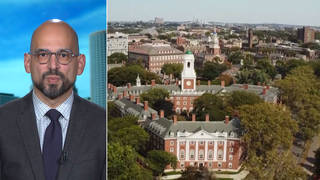
Guests
- Monique Verdincitizen of the United Houma Nation and part of Another Gulf Is Possible, a grassroots environmental group led by women of color.
Hurricane Ida has completely knocked out power to the city of New Orleans and reversed the flow of the Mississippi River after it hit southern Louisiana and Mississippi, flooding the area with storm surges. The Category 4 storm hit on the same date Hurricane Katrina devastated the area 16 years earlier. “This is a storm like no other,” says Monique Verdin, a citizen of the United Houma Nation and part of the grassroots collaborative Another Gulf Is Possible. “This is a part of South Louisiana that is losing land at one of the fastest rates,” Verdin notes. She also discusses how the storm hit the area as “Delta has been raging in the Mississippi River Delta.”
More from this Interview
- Part 1: Hurricane Ida Slams Native Communities in Louisiana as New Orleans Loses Electricity & COVID Rages
- Part 2: Hurricane Ida Hits Oil Industry in Black & Native Communities on Louisiana Coast Amid Climate Crisis
- Part 3: Exxon’s Oil Drilling Gamble Off Guyana Coast Could Turn Country from a Carbon Sink to a “Carbon Bomb”
Transcript
AMY GOODMAN: This is Democracy Now!, democracynow.org, The War and Peace Report. I’m Amy Goodman.
Hurricane Ida, one of the most powerful storms ever to hit the United States, roared ashore Sunday in southern Louisiana in an area dominated by the oil industry that’s also home to many Native communities. The storm brought a seven-foot storm surge, 150-mile-per-hour winds and up to two feet of rain to parts of the Gulf Coast. It was so powerful, it completely knocked out power to a million people, including the entire city of New Orleans, and reversed the flow of the Mississippi River. The Category 4 storm hit on the same day Hurricane Katrina devastated the area 16 years ago. It’s been blamed for at least one death, and more are expected.
A system of dikes and levees that protects the New Orleans region from rising waters is reportedly holding, for now, much of it built since Katrina. But still, it is underfunded, and officials say they could be overwhelmed by a forecasted 20 inches of rain.
Louisiana’s Gulf Coast is a major oil and gas hub, with 17 oil refineries, two liquefied natural gas export terminals, a nuclear power plant and many Superfund sites. Hurricane Ida made landfall near Port Fourchon, the oilfield service hub for almost all of the Gulf of Mexico and not far from the city of Houma.
In a minute, we’ll be joined by Monique Verdin, a citizen of the United Houma Nation, who just evacuated — the Houma Nation, one of the largest Native American tribes in North America. First, this is a trailer, though, for a documentary Verdin co-produced in 2012 called My Louisiana Love.
MONIQUE VERDIN: Our people have survived the natural cycle of floods and storms for centuries.
NARRATOR: In the bayous and swamps of Southeast Louisiana, filmmaker Monique Verdin explores her Native Houma roots.
MONIQUE VERDIN: I want to keep living on our land, but I’m inheriting a dying delta. Our love ties us to this place and makes us feel responsible to care for it.
NARRATOR: As Monique discovers, they’re battling their deadliest storm yet: the explosive growth of the oil and gas companies in the area.
DELTA RESIDENT: You see, the more gas and oil you got underneath your ground, the higher you’re going to sit. The more they’re going to pump, the lower your land is going to go.
CLARICE FRILOUX: We’ve been treated bad throughout the years, but this could destroy our tribe as a whole.
AMY GOODMAN: The trailer for the PBS documentary My Louisiana Love, co-produced by our guest, Monique Verdin, a citizen of the United Houma Nation. She has evacuated for Hurricane Ida. She’s also part of the collaborative Another Gulf Is Possible, which is now organizing mutual aid efforts to provide essential needs, repairs, supplies to the areas hit by Hurricane Ida.
Monique, thanks so much for joining us. I know this is a very difficult time. Can you explain the extent of the devastation that you’re hearing about, not only in Houma, but all over the area — a million people without power, all of New Orleans in the dark, people reporting they’re up to their chest in water?
MONIQUE VERDIN: Well, Amy, we’re really just starting to hear from folks. I know that many have just completely lost their homes. Many of our fishermen rode out the storm on their boats. We haven’t heard from a number of them. And there’s still — you know, everyone was waiting for the sun to come up, and that’s just happening. So, we’re not really sure, but we do know that there’s extreme flooding happening just to the west of the city. And all of those communities, all of the bayou communities, where the United Houma Nation, but also the Atakapa-Ishak of Grand Bayou and Plaquemines Parish, the Pointe-au-Chien Indian Tribe, the Biloxi-Chitimacha Confederation of Muskogee, Bands of Grand Caillou and Dulac, and the Isle de Jean Charles — you know, these are communities that often get left out of the news and have been weathering storms for many years. But this is a storm like no other.
AMY GOODMAN: So, talk about that. And talk about Houma. Talk about your community. And was a complete evacuation done of the Houma Nation?
MONIQUE VERDIN: No. The Houma are not ones to run from a storm. You know, we have boats and lands to take care of. And so, many people usually stay. More people evacuated this time than ever before. And we’ve all been scattered to the wind. Everyone went to whichever direction that they could, if they could. And many just went from the low-lying areas, that are just inside risk reduction levee systems, to higher grounds.
But they, too, you know, have — everyone is exhausted from just riding out the storm and the relentless wind and rains, that I’m hearing has been a very humbling experience. But we know that the disaster is only beginning to unfold. Hurricane Katrina really taught us that. Yes, the storm comes through, but the disaster keeps going for many years to come. And decisions get made in these moments, when people are completely disoriented and just trying to figure out how to get home. And at this moment, and knowing that all of Southeast Louisiana is out of power, when we get home and how we get home is a big question.
AMY GOODMAN: Can you talk about your family members who did not evacuate? Are you able to even be in contact with them? I mean, being in the dark is more than the actual darkness of the night, of course, as, as you said, people cannot communicate. Much of the rescue efforts can’t even start until today in daylight.
MONIQUE VERDIN: Yes. I have not spoken to very many. Social media is spotty, and I’m getting reports that cell service is also very spotty or nonexistent. I did get a text message in the middle of the night from a cousin saying that he didn’t think that he could get out of his home without a chainsaw, and also has — having no communication, so trying to be there for folks. But, you know, this is — everyone’s been kind of in shock. And now no one has power. No one has cell service. So, communication is going to be key.
AMY GOODMAN: Can you talk about the community that your relatives live in, called Big Woods, where there’s a waste pit in the flood areas? What does this mean? And we’re talking about scores of toxic sites that are directly in the hurricane’s path.
MONIQUE VERDIN: Yes. So, in the Yakni Chitto — it’s the “Big Country” between the Atchafalaya and Mississippi Rivers, where the majority of the Houma Nation still reside, at the ends of the bayous — this is a part of South Louisiana that is losing land at one of the fastest rates. And just to say to the audience, Louisiana is losing land at one of the fastest rates on the planet. The statistic is, every 100 minutes, a football field disappears from our shores. Of course, that’s a calculation divided over time, multiplied by disaster. So, you know, this is what we’re up against just in general.
And where these waste pits are, which are taking offshore oil and gas waste and “treating” it in these open-air pits, is just north of some of the fastest-deteriorating land on the planet and just south of what is the Houma Navigation Canal, which is a man-made canal. And this pit — these pits have been there for a very long time. And with every storm, this low-lying area, because of all of the levee infrastructure, too, that has been added since Hurricane Katrina, water goes towards the path of least resistance. And Grand Bois is left out of that levee system in a big way.
So, I haven’t gotten any reports from family in Grand Bois yet. I’m hoping to hear something today. The last photo I saw was a picture of my cousin’s house that was just completely flattened. So, what the water is like there, I’m not sure. Overnight, that’s when, you know, the surge just keeps — it had been pushing up against the levees all day. So —
AMY GOODMAN: And can you talk about climate change crashing into COVID? I mean, the reports on the South — Louisiana, Texas, Arkansas, Florida — you have oxygen running out in hospitals, where the patients who are dying are younger and younger. What does this mean at this time of the hurricane?
MONIQUE VERDIN: Delta has been raging in the Mississippi River Delta. Our hospitals have already been at capacity for weeks now. I read a report that one of the hospitals in Thibodaux actually — their generators, they lost power for a while and were having to manually pump oxygen into people who were in ICU and on ventilators that were not hooked up to the electrical system.
And it’s going to get really hot and humid, so wearing a mask is not ideal, and people are with each other and in each other’s homes at this time of evacuation and in the times of the disaster aftermath. You know, community is what gets you through this. And being in a time when we’re supposed to be social distancing and not being in the same space is really hard, especially when you’re going to start needing to rip out your walls and pull out your floors or, yeah, try to salvage what you have left.












Media Options